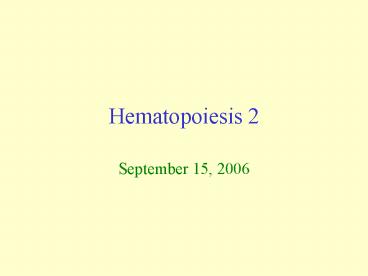Hematopoiesis 2 - PowerPoint PPT Presentation
1 / 24
Title:
Hematopoiesis 2
Description:
5. Define the terms ineffective erythropoiesis and extramedullary hematopoiesis ... Normal Bone Marrow Aspirate. Normal Bone Marrow Biopsy. Erythropoiesis ... – PowerPoint PPT presentation
Number of Views:1897
Avg rating:3.0/5.0
Title: Hematopoiesis 2
1
Hematopoiesis 2
- September 15, 2006
2
Outline
- review first hematopoiesis lecture
- talk about bone marrow aspiration biopsy
- talk about cell stages of hematopoiesis
3
Review
- Questions??
- Tell me the adult and fetal sites of
hematopoiesis - requirements for hematopoiesis
4
Remaining Objectives
- 5. Define the terms ineffective erythropoiesis
and extramedullary hematopoiesis and give
examples of their occurrence. - 6. Discuss reasons for bone marrow examination
including indications for aspirates and trephine
biopsies. Calculate and interpret
myeloiderythroid ratios (ME ratios). - 7. Recognize, describe and name all stages of
development of bone marrow and peripheral blood
cells including erythropoiesis, granulopoiesis,
and thrombopoiesis.
5
Terms to know
- extramedullary hematopoiesis
- formation of blood cells in sites other than
the bone marrow i.e. liver, spleen, - why? demand for cells
- erythropoiesis - rbc production
- granulopoiesis - wbc (granulocyte production)
- thrombopoiesis - platelet production
- ineffective hematopoiesis
- inability of the bone marrow to generate a
reasonable number of blood cells - multi or pluri potential stem cell
- also called a colony forming cell - the cell
that gives rise to all blood cells - the most
immature cell
6
Routes a stem cell can take
self-renew
- differentiate
7
(No Transcript)
8
Hematopoietic Cell Differentiation
- CFU-L pluripotential blast
colony-forming cell self renew - lymphocyte
- CFU-GEMM self renew
- BFU-E CFU-GM CFU-Eo CFU-Bas CFU-Meg
- CFU-E CFU-G CFU-M
- erythrocyte neutrophil monocyte eosinophil
basophil megakaryocyte
9
Indications for a Bone Marrow Examination
- Why do we exam bone marrow?
- To provide more information to diagnostic clues
seen in the peripheral blood - increase or decreased wbc, rbc or platelets
presence of abnormal or immature cells
10
BM required for the diagnosis of
- some types of anemia
- neutropenia
- leukemia
- suspected megakaryocyte abnormalities
- tumors
- storage diseases
- some infections
11
Bone Marrow Examination
12
Normal Bone Marrow Aspirate
13
Normal Bone Marrow Biopsy
14
Erythropoiesis
bone marrow Sinusoidal circulation
wall CFU-E mature
red cell pronormoblast
basophilic normoblast
reticulocyte polychromatic
normoblast orthochromatic normoblast
15
(No Transcript)
16
Normal RBC Maturation Series
- 1. pronormoblast (rubriblast)
- 2. basophilic normoblast (prorubricyte)
- 3. polychromatic normoblast (rubricyte)
- 4. orthochromatic normoblast (metarubricyte)
- 5. reticulocyte (diffusely basophilic rbc)
- 6. mature erythrocyte
17
Nutritional Requirements for Erythropoiesis
- 1. protein and amino acids
- 2. vitamin B12 and folic acid
- 3. vitamin B6 (pyridoxine)
- 4. vitamin C
- 5. iron
- 6. copper
- 7. cobalt
18
Granulopoiesis
bone marrow precursors proliferating
mature/storage blood
tissue myeloblast
segmented GM-CFU circulating
31x107/kg band promyelocyte
myelocyte marginating GEMM-CFU
39x107/kg metamyelocyte
1.5x109/kg day-1
19
(No Transcript)
20
Granulopoiesis Statistics
- takes 8 -12 hours per cycle
- 7 - 11 days
- neutrophils circulate for 6 - 8 hours
- live in tissues 48 hours
21
Thrombopoiesis
Bone Marrow Precursors Proliferating
Endoreduplicating Blood
Tissue CFU-Meg 1N 2N
8N 32N
Megakaryoblast
Megakaryocyte CFU-GEMM
Platelets Circulating
and Marginating
22
(No Transcript)
23
(No Transcript)
24
Thrombopoiesis
- endoreduplication - doubling of DNA without the
cell dividing - marginating pool for emergencies
- at any given time 30 of platelets are in the
spleen































